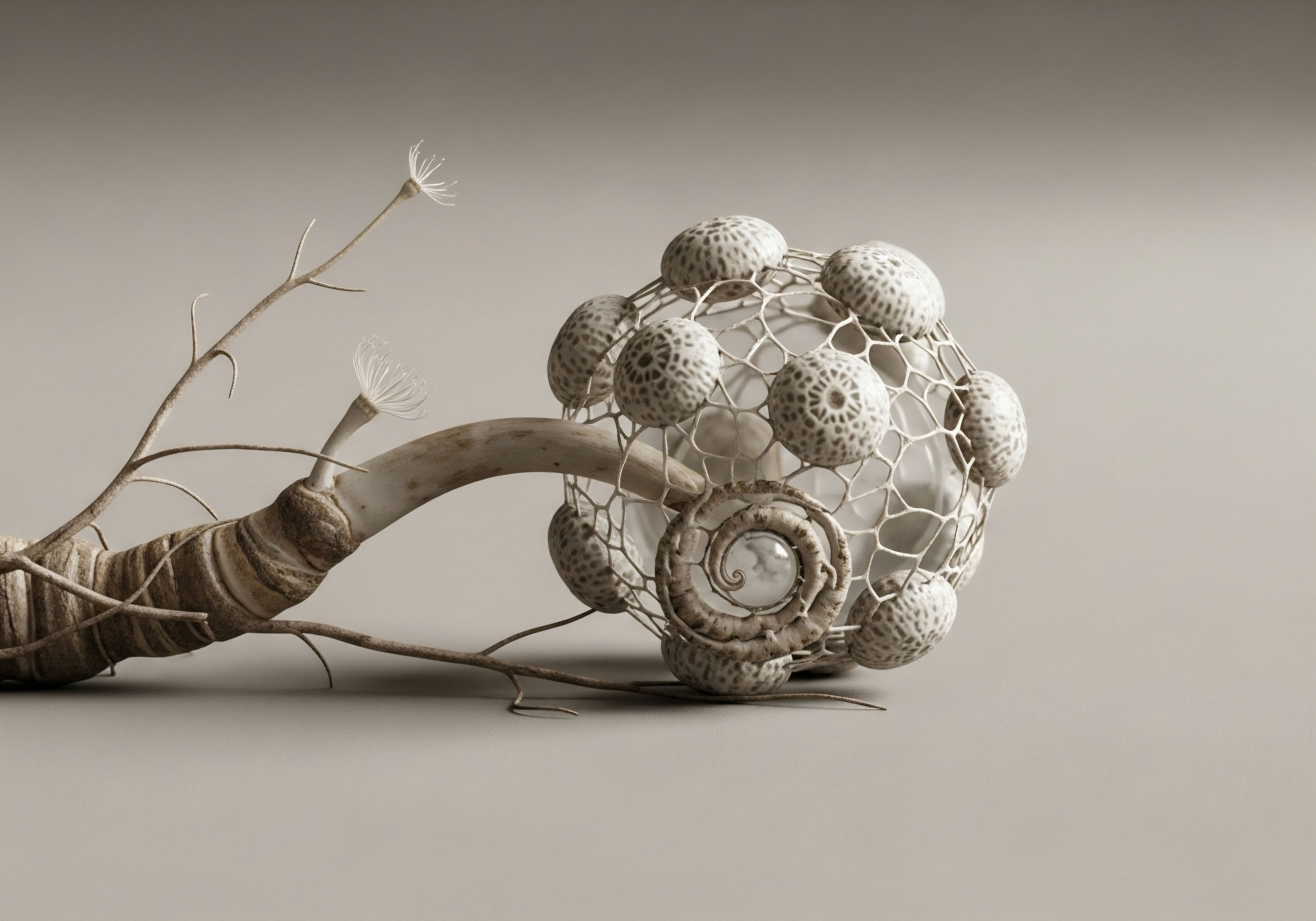

Fundamentals
When you first notice a change in your body, a sense of concern is a natural, human response. The observation that your testicles may be smaller is a deeply personal one, and it brings with it valid questions about what this means for your health, your vitality, and your future.
This experience is the starting point for a deeper understanding of your own biological systems. The path to reclaiming function begins with translating that personal concern into clear, biological knowledge. Testicular size is a direct reflection of a complex and dynamic biological conversation happening within your body every second. This conversation is orchestrated by the endocrine system, with the testicles acting as a primary manufacturing center for both sperm and the hormone testosterone.
The core of this operation is the Hypothalamic-Pituitary-Gonadal (HPG) axis. Think of this as the command-and-control pathway for your reproductive and hormonal health. It begins in the brain, where the hypothalamus sends a signal, Gonadotropin-Releasing Hormone (GnRH), to the pituitary gland.
The pituitary, in turn, releases two critical messenger hormones into the bloodstream ∞ Luteinizing Hormone (LH) and Follicle-Stimulating Hormone (FSH). LH travels to the Leydig cells in the testes, instructing them to produce testosterone. FSH signals the Sertoli cells to support sperm production. Testicular volume is maintained when this entire system is active and fully engaged. The tissue is metabolically busy, receiving clear signals from the brain and robust blood flow to deliver nutrients and carry away hormones.
Testicular atrophy is the physical result of a breakdown in the signaling, structure, or fuel supply required for normal testicular function.
Testicular atrophy, the clinical term for the shrinkage of the testicles, occurs when this process is disrupted. It is a loss of the key cellular machinery ∞ the Leydig cells that produce testosterone and the germ cells that mature into sperm. This disruption can happen for several reasons.
One of the most direct is a loss of signal from the brain. If the HPG axis is suppressed, the pituitary reduces its output of LH and FSH. Without these stimulating signals, the testicular tissue becomes dormant and begins to shrink. This is precisely what happens with the use of anabolic steroids or even with improperly managed Testosterone Replacement Therapy (TRT), as the body senses high levels of external hormones and shuts down its own production line.
Other factors can also lead to atrophy by compromising the physical environment of the testicles. A varicocele, which is an enlargement of veins in the scrotum, can impair blood flow and increase temperature, creating a hostile environment for the delicate cells involved in hormone and sperm production.
Direct trauma or testicular torsion, a medical emergency where the spermatic cord twists and cuts off blood supply, can cause rapid and severe tissue damage. Furthermore, systemic influences like chronic illnesses or excessive alcohol consumption can harm testicular tissue directly, interfering with its ability to function even when hormonal signals are present. Understanding these mechanisms is the first step in identifying the correct path toward restoration.


Intermediate
To understand how lifestyle interventions can influence testicular health, we must first appreciate the intricate feedback loops that govern the system. The HPG axis functions like a sophisticated thermostat. The hypothalamus and pituitary are constantly monitoring levels of testosterone in the blood. When levels are optimal, they reduce the release of GnRH and LH to maintain balance.
When levels fall, they increase the signals to stimulate more production. Lifestyle choices are powerful modulators of this system’s efficiency. They provide the raw materials and create the metabolic conditions necessary for the HPG axis to function correctly. Diet and exercise are the foundational inputs that support the entire hormonal architecture.

How Do Diet and Exercise Support Hormonal Balance?
A well-formulated diet provides the essential building blocks for hormone synthesis. Testosterone itself is derived from cholesterol, and a diet devoid of healthy fats can limit the availability of this crucial precursor. Specific micronutrients also play indispensable roles as cofactors in the enzymatic reactions that create hormones.
- Zinc This mineral is vital for the synthesis of testosterone and for maintaining sperm quality. A deficiency can directly impair testicular function. Foods rich in zinc include lean meats, shellfish, legumes, and seeds.
- Vitamin D Often called the “sunshine vitamin,” this steroid hormone precursor is critical for male reproductive health. Its receptors are found in testicular tissue, indicating its direct role in testosterone production and spermatogenesis.
- Healthy Fats Monounsaturated fats and omega-3 fatty acids are essential for cellular health and hormone production. Sources like avocados, nuts, seeds, and fatty fish help maintain the structural integrity of cells and provide the cholesterol backbone for steroid hormones.
- Antioxidants Compounds found in colorful fruits and vegetables help combat oxidative stress, which is cellular damage caused by reactive oxygen species. The testes are highly metabolically active and susceptible to this type of damage.
Exercise, particularly resistance training, provides a powerful stimulus for the endocrine system. Lifting heavy weights creates a physiological demand that signals the body to increase its production of anabolic hormones, including testosterone. This type of physical stress, when applied in appropriate doses and followed by adequate recovery, strengthens the HPG axis signaling.
It improves insulin sensitivity, reduces body fat, and lowers chronic inflammation, all of which create a more favorable metabolic environment for optimal testosterone production. Conversely, chronic overtraining without sufficient rest can elevate cortisol, a stress hormone that actively suppresses the HPG axis and lowers testosterone.
Lifestyle choices create the optimal biological environment for hormonal health, but they cannot surgically repair a physical defect or override a direct pharmacological suppression.

The Limits of Lifestyle Intervention
While diet and exercise are fundamental for supporting testicular function, their ability to reverse existing atrophy is conditional upon the root cause. If atrophy is the result of nutritional deficiencies, poor metabolic health, or a sedentary lifestyle, then targeted changes can indeed improve the system’s function and potentially restore some testicular volume over time. These interventions work by removing obstacles and providing the necessary resources for the body’s natural processes to resume.
However, when atrophy is caused by a primary, overriding factor, lifestyle changes alone are typically insufficient for a complete reversal. For instance, no amount of dietary zinc can reopen a twisted spermatic cord in testicular torsion. No resistance training regimen can force the pituitary to send LH signals when it is being actively suppressed by high doses of external anabolic steroids.
In these scenarios, the primary problem must be addressed directly through medical intervention. Lifestyle modifications then become a critical component of the recovery and maintenance phase, ensuring the restored system has the support it needs to remain healthy.
| Factor | Supportive Actions | Detrimental Actions |
|---|---|---|
| Nutrition |
Consume a diet rich in zinc, vitamin D, healthy fats, and antioxidants. Maintain a healthy body composition. |
Consume highly processed foods, excessive sugar, and unhealthy fats. Suffer from nutrient deficiencies. |
| Exercise |
Engage in regular resistance training and moderate cardiovascular exercise. Allow for adequate recovery. |
Live a sedentary lifestyle or engage in chronic overtraining without proper rest and nutrition. |
| Substances |
Maintain hydration and avoid endocrine-disrupting chemicals where possible. |
Consume excessive alcohol, smoke tobacco, or use illicit drugs and anabolic steroids. |
| Stress |
Practice stress management techniques like mindfulness or meditation. Prioritize adequate sleep. |
Experience chronic psychological stress and sleep deprivation, leading to elevated cortisol levels. |


Academic
From a clinical and molecular perspective, testicular atrophy represents a state of suppressed steroidogenesis and failed gametogenesis. The reversal of this condition depends on correctly identifying the point of failure within the Hypothalamic-Pituitary-Gonadal (HPG) axis and applying a targeted intervention to restore its function.
While lifestyle factors modulate the systemic environment, they often lack the specificity and potency to restart a stalled endocrine engine. The primary therapeutic strategies involve the use of pharmacological agents that mimic or stimulate the body’s endogenous hormonal messengers.

What Is the Cellular Basis of Testicular Atrophy?
The volume of the testes is predominantly determined by the mass of the seminiferous tubules, where spermatogenesis occurs, and the interstitial tissue containing the Leydig cells. Atrophy involves the apoptosis, or programmed cell death, of these critical cell populations.
In cases of exogenous androgen use (anabolic steroids or TRT), the persistently high levels of circulating androgens provide strong negative feedback to the hypothalamus and pituitary. This suppresses the secretion of GnRH and, consequently, LH and FSH. Without the trophic support of LH, Leydig cells cease testosterone production and undergo involution. The absence of FSH and intratesticular testosterone leads to a halt in spermatogenesis and the shrinkage of the seminiferous tubules. The entire organ becomes quiescent.

Pharmacological Reversal Strategies
Reversing this state of quiescence requires a direct and powerful stimulus to the HPG axis. Clinical protocols are designed to “reboot” the system at specific points in the signaling cascade. These interventions are a testament to the fact that a direct biochemical signal is needed to overcome the induced suppression.
- Gonadorelin Analogs These substances are synthetic versions of GnRH. When administered in a pulsatile fashion, they can stimulate the pituitary gland to resume its secretion of LH and FSH. This approach essentially reactivates the very top of the signaling pathway, making it a comprehensive method for restarting the entire axis. It is often used to maintain testicular function during TRT or to restore it afterward.
- Human Chorionic Gonadotropin (hCG) This hormone is a powerful LH analog. It bypasses the hypothalamus and pituitary altogether and directly stimulates the LH receptors on the Leydig cells in the testes. This forces the testes to resume testosterone production, which in turn increases intratesticular testosterone levels and helps support spermatogenesis. This is the most direct and common method for reversing testicular atrophy caused by hormonal suppression.
- Selective Estrogen Receptor Modulators (SERMs) Compounds like Clomiphene Citrate and Tamoxifen work at the level of the hypothalamus and pituitary. They block estrogen receptors in the brain. Since estrogen is part of the negative feedback loop, blocking its action tricks the brain into thinking hormone levels are low. This causes an increase in the production of GnRH, LH, and FSH, leading to a natural increase in testicular stimulation.
Clinical interventions for testicular atrophy work by delivering a precise hormonal signal that lifestyle modifications cannot replicate.
These protocols demonstrate a core principle of endocrinology ∞ reversing a state of severe functional decline requires an intervention that matches the potency of the initial insult. Lifestyle changes such as diet and exercise are indispensable for creating a foundation of metabolic health upon which these therapies can act most effectively.
They ensure the body has the raw materials for hormone synthesis and low levels of systemic inflammation. After a successful pharmacological reversal of atrophy, these same lifestyle factors are paramount for maintaining long-term testicular health and overall endocrine balance.
| Therapeutic Agent | Mechanism of Action | Primary Clinical Application |
|---|---|---|
| Gonadorelin |
Pulsatile stimulation of GnRH receptors in the pituitary gland, increasing LH and FSH release. |
Maintaining HPG axis function during TRT; post-cycle therapy to restore endogenous production. |
| Human Chorionic Gonadotropin (hCG) |
Directly stimulates LH receptors on Leydig cells, inducing testosterone and sperm production. |
Reversing testicular atrophy caused by TRT or anabolic steroid use; treating hypogonadism. |
| Clomiphene Citrate (Clomid) |
Acts as a SERM, blocking estrogen feedback at the hypothalamus, thereby increasing GnRH, LH, and FSH. |
Male infertility treatment; post-cycle therapy; an alternative to TRT in some cases of secondary hypogonadism. |
| Anastrozole |
Aromatase inhibitor that blocks the conversion of testosterone to estrogen, managing potential side effects. |
Used adjunctively with TRT or hCG to control estrogen levels and mitigate side effects like gynecomastia. |

References
- GarbhaGudi IVF Centre. “Testicular atrophy ∞ Causes, diagnosis, and treatment.” 2023.
- Wikipedia contributors. “Testicular atrophy.” Wikipedia, The Free Encyclopedia.
- Nova IVF Fertility. “Testicular Atrophy ∞ Definition, Causes, Symptoms, and Treatment.” 2023.
- Taylor & Francis Online. “Testicular atrophy ∞ Knowledge and References.” 2021.
- Fletcher, Jenna. “Testicular atrophy ∞ Causes, diagnosis, and treatment.” Medical News Today, 2023.
- Holland, Kimberly. “Testicular Atrophy ∞ Symptoms, Causes, and Treatment.” Healthline, 2017.
- Genesis Lifestyle Medicine. “Can You Reverse Testicle Shrinkage After TRT?.” 2024.
- Tactus Health. “How to Reverse Testicular Shrinkage After TRT | 4 Strategies.” 2024.

Reflection

Charting Your Path Forward
The information presented here provides a map of the biological territory you are navigating. It connects the personal experience of a physical change to the intricate systems that govern your health. This knowledge is a powerful tool, shifting the perspective from one of uncertainty to one of informed action.
Your body is a responsive system, constantly adapting to the signals it receives, whether they come from your diet, your physical activity, or targeted medical protocols. Understanding this responsiveness is the first step. The next is to use this understanding to ask more precise questions and to engage in a productive dialogue with a qualified healthcare professional who can help interpret your unique situation.
Your personal health journey is a collaborative process, one where your lived experience and clinical data come together to create a personalized path toward optimal function and well-being.

Glossary

endocrine system

sertoli cells

leydig cells

testicular atrophy

anabolic steroids

hpg axis

varicocele

diet and exercise

testicular function

testosterone production

oxidative stress

gonadorelin

reversing testicular atrophy caused

human chorionic gonadotropin

clomiphene citrate

reversing testicular atrophy




